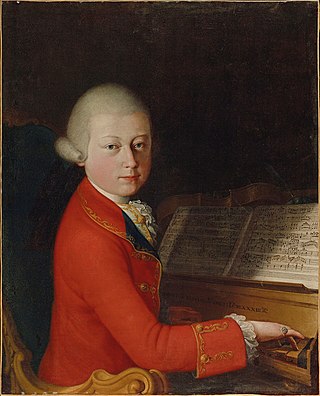
Symphony No. 21 in A major, K. 134, is a symphony that was composed by Wolfgang Amadeus Mozart in August 1772. [1]

Symphony No. 21 in A major, K. 134, is a symphony that was composed by Wolfgang Amadeus Mozart in August 1772. [1]
The symphony has the scoring of two flutes, two horns, and strings. [1]

There are four movements:

The Symphony No. 25 in G minor, K. 183/173dB, was written by the then 17-year-old Wolfgang Amadeus Mozart in October 1773, shortly after the success of his opera seria Lucio Silla. It was supposedly completed in Salzburg on October 5, a mere two days after the completion of his Symphony No. 24, although this remains unsubstantiated. Its first movement was used as the opening music in Miloš Forman's film biographical Amadeus.

The Symphony No. 5 in B♭ major, K. 22, was composed by Wolfgang Amadeus Mozart in The Hague in December 1765, at the age of nine, while he was on his musical tour of Western Europe. Mozart fell seriously ill during his stay in The Hague, and he wrote this composition probably while he was convalescing from his illness.

Symphony No. 16 in C major, K. 128, was the first of three symphonies composed by Wolfgang Amadeus Mozart in May 1772 when Mozart was sixteen years old. This symphony is one of many written during the period in which Mozart stayed in Salzburg, between two trips to Italy. The autograph of the score is preserved in the Berlin State Library.

Symphony No. 20 in D major, K. 133, was composed by Wolfgang Amadeus Mozart in July 1772, when Mozart was sixteen years old. This symphony is one of many written during the period Mozart stayed in Salzburg, between two trips to Italy. Compared to other symphonies Mozart wrote in this period, the scoring is extravagant, featuring two trumpets in addition to the standard oboes, horns, and strings. The key of D major, which is a key often reserved for ceremonial music, is well suited to the presence of these trumpets.

The Symphony No. 4 in D major, K. 19, by Wolfgang Amadeus Mozart was composed in London during the Mozart family's Grand Tour of Europe in 1765, when Mozart was nine years old.

Symphony No. 34 in C major, K. 338, was written by Wolfgang Amadeus Mozart in 1780, and completed on 29 August that year.

Symphony No. 14 in A major, K. 114, is a symphony composed by Wolfgang Amadeus Mozart on December 30, 1771, when Mozart was fifteen years old, and a fortnight after the death of the Archbishop Sigismund von Schrattenbach. The piece was written in Salzburg between the composer's second and third trips to Italy. Mozart was also influenced by J. C. Bach's "Italianate" style of composition".

The Symphony No. 26 in E♭ major, K. 184/161a, was written by Wolfgang Amadeus Mozart and completed on March 30, 1773, one month after he returned from his third Italian tour.

Symphony No. 11 in D major, K. 84/73q, was at one time considered unquestionably to be the work of Wolfgang Amadeus Mozart. Its status has, however, been challenged, and remains uncertain. It is believed to date from 1770, and may have been written in Milan or Bologna, if it is a genuine Mozart work. An early manuscript from Vienna attributes the work to Wolfgang, but nineteenth-century copies of the score attribute it respectively to Leopold Mozart and to Carl Dittersdorf. Neal Zaslaw writes: "A comparison of the results of two stylistic analyses of the work's first movement with analyses of unquestionably genuine first movements of the period by the three composers suggests that Wolfgang is the most likely of the three to have been the composer of K73q".

Symphony No. 17 in G major, K. 129, is the second of three symphonies completed by Wolfgang Amadeus Mozart in May 1772, when he was 16 years old, but some of its sections may have been written earlier.

Symphony No. 18 in F major, K. 130, was the last of three symphonies composed by Wolfgang Amadeus Mozart in May 1772, when he was sixteen years old.

Symphony No. 19 in E-flat major, K. 132, is a symphony composed by Wolfgang Amadeus Mozart in July 1772.

Symphony No. 22 in C major, K. 162, is a symphony composed by Wolfgang Amadeus Mozart in April 1773. The symphony has the scoring of two oboes, two horns in C, two trumpets in C, and strings.

The Symphony No. 23 in D major, K. 181/162b, by Wolfgang Amadeus Mozart was dated as complete on May 19, 1773. It is sometimes called "Overture", even though the autograph score bears the title "Sinfonia". The symphony is scored for 2 oboes, 2 horns in D, 2 trumpets in D, and strings.

Symphony No. 24 in B-flat major, K. 182/173dA, is a symphony composed by Wolfgang Amadeus Mozart, completed in Salzburg on 3 October 1773. The symphony is scored for 2 oboes, 2 horns in B-flat, and E-flat for the second movement, and strings.
The Symphony "No. 43" in F major, K. 76/42a, was probably written by Wolfgang Amadeus Mozart.
The Symphony in D major "No. 51", K. 196+121 (207a, was composed by Wolfgang Amadeus Mozart in 1774–1775. The first two movements are from the overture to the opera La finta giardiniera, K. 196, and the last movement, K. 121/207a, was composed separately in 1775.
The Symphony in D major "No. 45", K. 95/73n, was probably written by Wolfgang Amadeus Mozart in 1770 in Rome.
The Symphony in D major "No. 47", K. 97/73m, was probably written by Wolfgang Amadeus Mozart in 1770 in Rome.
The Symphony in D major "No. 44", K. 81/73l, may have been written by Wolfgang Amadeus Mozart in 1770 in Rome, although it has sometimes also been attributed to his father Leopold Mozart. It is now also catalogued as Eisen D 14 in Cliff Eisen's catalogue of Leopold Mozart's symphonies.